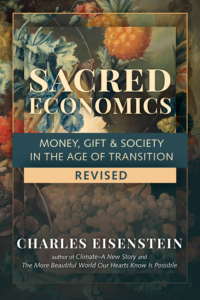Climate — A New Story
Chapters
Chapter 5: Carbon: The Ecosystems View
Carbon, Soil, and Life
In this book I have intentionally placed the water chapter in front of the carbon chapter, signaling the possibility that we need to reverse priorities in our consideration of these two substances so foundational to life. Nonetheless, carbon also offers an important window onto the health of the Gaian organism. Ultimately, it opens onto the same understanding that water does: that we need to shift our attention to ecosystems, soil, and biodiversity.
Most discourse about greenhouse gases focuses on emissions from fossil fuels, how to replace them with alternative energy sources, and whether it is possible to do this quickly enough. This is well-trodden territory. I will not weigh in on it, because I don’t want to give more attention to what I consider to be the wrong conversation. Whether or not we reduce emissions, in the absence of ecological healing on every level, climate derangement will continue to worsen.
To enter the ecosystems paradigm through the carbon lens, we must look at an item of the carbon budget that is much less certain than fossil fuel emissions—the release of carbon from “land use changes” (a euphemism for ecosystem destruction)—and, equally uncertain, the capacity of intact ecosystems to absorb and sequester carbon.
Some researchers believe we have drastically underestimated both,[1] and the general trend in the literature has been toward higher and higher estimates for terrestrial fluxes of CO2. For example, a recent study concludes that tropical deforestation of 2.27 million square kilometers has contributed about 50 gigatons of carbon to the atmosphere since 1950, and the rate of emission has accelerated.[2] According to this study, emissions from tropical deforestation currently total 2.3 gigatons/year—more than 20 percent of anthropogenic emissions, and much more than previous estimates.[3] A similar trend applies to other biomes.
Quite possibly, the effect of deforestation, soil loss, biodiversity loss, swamp and peat bog draining, draining of mangroves, and other land use changes is so severe that one could reasonably argue—even in the carbon (as opposed to water) frame—that climate change is caused by these activities as much as by burning fossil fuels. Fossil fuel burning intensifies the instability that ecological devastation would cause anyway.
I recently read on a climate skepticism blog the claim that from 1750 to 1875, atmospheric CO2 rose far faster than cumulative anthropogenic emissions, and that the latter didn’t catch up with the former until 1960.[4] The author argues that CO2 rose as a result of rising temperatures (rather than causing them), a common skeptic position. There is another possibility, though: the period in question was also a time of massive deforestation in Europe and North America, along with the vast expansion of farmland. These sources of CO2 may have dwarfed fossil fuel emissions.
The previous chapter described the process by which deforestation, conventional agriculture, and other land abuse emit carbon into the atmosphere from exposed and eroded soil. Here are a few examples of the other side of the equation: the capacity of intact ecosystems to absorb and store carbon underground.
Wetlands
Where should I begin the sad news? That the planet has lost half its mangrove swamps in the last century, and about 70 percent of its total wetlands?[5] That seagrass meadows are declining by 7 percent per year?[6] That total wetlands loss in the United States stands at 50 percent since its founding, and has accelerated in the twenty-first century over the twentieth?[7] Most of the losses are due to agricultural conversion, urban growth, and coastal development; meanwhile, intact wetlands suffer degradation from pollution and saltwater encroachment. Rising sea levels ordinarily wouldn’t be a problem, because coastal wetlands would migrate, but today levees constrain their spread, even as dams deprive them of sediment to grow.
From the standpoint of biodiversity wetlands degradation is catastrophic, but what about carbon? Wetlands deposit more carbon in soil than any other ecosystem—in the case of seagrass, as high as 20 tons per hectare per year.[8] Together with mangroves and salt marshes, wetlands account for half of biological carbon capture globally according to some estimates.[9] Peatlands are another massive carbon sink, containing as much carbon in their soil as all living biomass on Earth, carbon that can enter the atmosphere when the peatlands are drained, deforested, or burned.
Sequestration rates for these and other ecosystems are typically determined by measuring soil accumulation rates. This method partakes in the basic scientific strategy of isolating variables, rendering invisible the synergistic connections among systems. Mangroves, for example, trap sediment that would otherwise disturb the coral reefs beyond them, possibly making them more vulnerable to bleaching. Seagrass buffers the acidity of the surrounding water, allowing faster shellfish growth. Both shellfish and coral reefs biosequester carbon in their own right. The basic methodology of carbon accountancy—divide the earth into biomes and regions and add up the carbon sequestration of each—inherently underestimates the value of each.
Grasslands
Intact grasslands inhabited by herds of large herbivores have a tremendous capacity to sequester carbon in the soil. Data in terms of tons of carbon per hectare is hard to pinpoint because estimates obtained through measurement and modeling vary by several orders of magnitude, depending on geological conditions, rainfall, types of grasses and whether they are cut, and the presence or absence of herd animals (whether wild or domesticated livestock). Furthermore, sequestered carbon can remain in the soil for varying lengths of time. Some carbon-containing soil organic matter decomposes in a year or two, much of it remains in the soil for a few decades, and some isn’t recycled back into the atmosphere for thousands of years (if ever). The ten-foot-thick topsoil of the American Midwest (much eroded today) testifies to the ability of grasslands to store carbon underground.
The highest carbon storage comes from native grass mixes occupied by large, roaming herds of herbivores. Sadly, 97 percent of the original North American highgrass prairie has been converted to cropland, suburbs, and sown pasture. Originally covering 70 million hectares, its carbon-regulating capacity was enormous. Judging by the data, albeit sparse, coming from management-intensive grazing practices that seek to replicate natural herbivore grazing behavior, it is conceivable that highgrass prairie could sequester 8–20 tons of carbon per hectare per year. Today, instead, most of this land is a carbon emitter, because it is cultivated for crops.[10] Plow-based cultivation that exposes bare soil to the air, water, and wind makes its organic matter (carbon) available for oxidation. A similar story has transpired in the steppes of Asia, the veldts of Africa, the pampas of South America, and so on. According to the FAO, up to a third of global grassland has already been degraded.[11] What could be a carbon sink is becoming an emissions source.
Forests
Of all ecosystems, the general public recognizes forests to be crucial for maintaining climate health. At present they absorb about 40 percent of global anthropogenic emissions—and emit at least a third of that due to deforestation.[12] The more CO2 in the air, the more they absorb—up to a limit. It is as if they are valiantly doing their best to keep the atmosphere in balance. We humans are not helping. According to some estimates, the total number of trees on earth has fallen by nearly half since the dawn of civilization;[13] today, hundreds of thousands of square kilometers of forest disappear every year. The losses may be even worse than commonly estimated, as deforestation statistics fail to include fine-level tree loss, which according to some researchers accounts for two-thirds of biomass loss from tropical forests.[14] As with wetlands and grasslands, destruction of forests turns land from a carbon sink to a carbon source.
Less recognized as a problem than deforestation is forest degradation, primarily a result of logging, insect damage, and forest fires—three factors that are intimately related. Contrary to timber industry claims, logging renders forests more susceptible to catastrophic fires, not less.[15] As described in the last chapter, it creates drier conditions by reducing transpiration and increasing runoff and erosion. Logging also disrupts the ecological balance that keeps insects in check. Typically, it homogenizes the forest, leaving it more susceptible to insects and disease, the stumps of felled trees offering a breeding ground for both. Meanwhile, since logging eliminates standing dead trees and the hollows of older trees, important habitat disappears, increasing the risk of insect and pathogen outbreaks. Roads used for heavy machinery result in soil compaction and the fragmentation of ecosystems, further reducing resiliency.[16] None of these effects is accurately encompassed by carbon metrics or climate models.
Furthermore, if we understand that forests themselves are living beings (rather than mere aggregates of living beings), other kinds of damage become visible. Mycelial networks of phenomenal complexity tie together all the trees and other plants in a forest, providing a communication network through which trees share information, alert each other to pests, and sometimes even share resources. Roads chop up this living web into smaller, disconnected pieces. Conventional logging also prevents trees from reaching a very great age and from falling and slowly rotting over a period of decades or centuries. What if the most elder of the trees, the grandmother trees, contain wisdom (or, if you prefer, chemically encoded information) that is useful for the forest to endure unusual once-in-a-century conditions? What if the rotting trees host slow-developing fungi that play an important role in maintaining ecological balance? All of these phenomena are much harder to quantify than metric tons of biomass.
In his 2016 book The Hidden Life of Trees, forester Peter Wohlleben makes a strong case for forest sentience and the social nature of trees. His team used radionuclide-marked sugars to establish that healthy trees feed sick trees, and that parent trees nourish their offspring. Sometimes the tree community even keeps the stumps of felled trees alive for centuries. They communicate through airborne chemicals as well as through mycelial networks; they also learn, individually and collectively, from experiences with drought and other threats.[17] Some trees form friendships with other trees, cooperating rather than competing for sunlight. Trees also cooperate to create microclimates: in one study that Wohlleben mentions, naturally growing forests maintained temperatures 3 degrees cooler than in managed areas.
Perhaps the ecological crisis that we frame in terms of climate change and global boundaries will be resolved only when it has brought us to a place where we recognize the aliveness of forests and all things. Only then will we have the knowledge and skill necessary to properly care for the tissues and organs of the Gaian body. But aliveness becomes invisible when a forest or other being is reduced to a dataset.
The living being we call a forest includes not just trees, but all the beings that live there. How would one put a number on the contributions of, say, a population of wolves? Apex predators are crucial in maintaining robust ecosystems, even though they make no direct contribution to carbon sequestration. Their contribution is indirect, systemic, and diffuse. In North American forests, the extermination of wolves and cougars has led to burgeoning deer populations, which consume understory vegetation and new saplings, leaving soil exposed, increasing runoff and erosion, reducing water retention, and contributing to reduced rainfall during dry seasons and flooding during wet seasons. Changes in ground and understory vegetation also reverberate through insect, fungal, and bacterial communities, making trees vulnerable to insects and disease, and then to fire. Logging, acid rain, ozone pollution, and changing climatic patterns exacerbate these effects in a wicked synergy. For reasons that are unique to each place, forests are in decline all over the world.
I could quote more figures for aboveground and belowground carbon sequestration for different forest types: tropical, temperate, and boreal, primary closed-canopy forests and second growth forests, and so on. But come on, people, do we really need these numbers to know that we must conserve and treasure our precious forests? Even if we could live on a planet barren of them, would we want to? When is the tree-killing going to stop? I am hesitant to go into more numbers, wary of implying that it is the numbers we should be talking about. Will it help to pile on more quantitative reasons for why we should do what we already know we should do? I don’t think so.
If we don’t yet know the forests are sacred and precious, more numbers aren’t going to help.
A forest is a living being of inconceivable complexity. When we reduce it to a small set of generic relationships and numerical quantities, we set the stage for violence: their physical reduction by chainsaws and bulldozers follows their conceptual reduction into measurable quantities and services. That is why I hesitate to frame the value of forests in terms of carbon. It leaves out their noncarbon ecosystem services, as well as their inherent worth, turning the conversation toward numbers.
Reducing a forest to numbers like biomass and sequestration rates is not so different from reducing them to board feet and dollars. It is the same way of thinking. I refuse to proceed with it any longer.
End Notes
[1] See, for example, Arneth et al. (2017).
[2] Rosa et al. (2016).
[3] Estimates of carbon sunk into rainforest biomass have been increasing. A 2012 paper in Nature Climate Change (Baccini et al., 2012) put the figure at 228.7 gigatons, fully 21 percent higher than the 2010 estimate of the Global Forest Resources Assessment (Food and Agriculture Organization of the United Nations, 2010). Nonetheless, the Nature Climate Change paper’s estimate of annual emissions from tropical deforestation is less than half the Current Biology figure above, probably because it does not consider below-ground biomass and legacy emissions.
[4] Middleton (2012).
[5] Davidson (2014).
[6] Waycott et al. (2009).
[7] Fears (2013).
[8] Duarte et al. (2013). This figure combines measurements and modeling over a fifty-year timespan for restored seagrass meadows (natural ones would presumably outperform them). It observes that sequestration rates increase exponentially with time (until reaching a limit), implying that many previous studies conducted on short-term replanting projects grossly underestimate seagrass’s carbon sequestration potential. Approximately 30–60 million hectares of seagrass worldwide sequestering 20 tons/hectare give as much as a gigaton of carbon absorbed every year—one-tenth as much as anthropogenic emissions.
[9] Nellemann et al. (2009). Note that the sequestration figures given in this report are lower than more recent estimates.
[10] For more on this, see chapter 8 on regenerative agriculture. Most estimates are an order of magnitude less than these figures, but on the other hand the American highgrass prairie represents only 2 percent of global grassland.
[11] Food and Agriculture Organization of the United Nations (2009).
[12] Pan et al. (2011).
[13] Crowther et al. (2015).
[14] Baccini et al. (2017).
[15] Wuerthner (2016).
[16] See, for example, Sierra Forest Legacy (2012).
[17] For an introduction to Wohlleben’s work, I recommend the excellent interview by Schiffman (2015).






